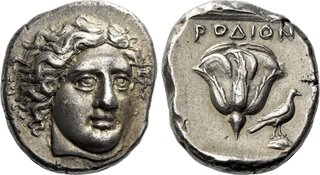| Numismatica Ars Classica > Auction 146 | Auction date: 8 May 2024 |
| Lot number: 2230 Price realized: This lot is for sale in an upcoming auction - Bid on this lot  | Show similar lots on CoinArchives Find similar lots in upcoming auctions on |
| Lot description: Rhodes. Tetradrachm circa 404-385, AR 24 mm, 15.26 g. Head of Helios facing three-quarters r. Rev. ΡΟΔΙΟΝ Rose; in lower field r., eagle standing r. with closed wings on rock. All within shallow incuse square. de Hirsch 1556 (these dies). Ashton, Essays Carson-Jenkins 1 (this coin). SNG Keckman 359. Bérend, 7 (this coin). HNO Online 1 (this coin). Ashton IGCH IX, p. 140, 16a (this coin). Rare. An impressive portrait struck in high relief and with a light iridescent tone. Extremely fine Ex Triton sale VI, 2003, 442. From the Marmaris hoard (IGCH 1209). The coinage of Rhodes has been the subject of intensive study in recent decades, and many aspects of the series are now more clearly defined. Coinage for 'Rhodes' commenced in 408/7 B.C. after the citizens of three major cities on the island largely abandoned their ancestral homes to create a new city, Rhodes, on the northern tip of their island. This bold act was the catalyst by which Rhodes became a powerful maritime state that prospered throughout the political chaos of the Greek world during the forthcoming age of the Hellenistic monarchies. This Chian-weight tetradrachm was struck in the midst of the period of great production at Rhodes, by which time the mint's engravers were routinely producing facing heads of excellent style in high relief. This series covers nearly two decades that span the tail end of the 5th and the early years of the 4th Century B.C.; it includes 41 different symbols and control letters that have thus far been identified, though statistical analysis suggests more are yet to be discovered. Perhaps the most surprising aspect of Rhodian coinage from this period is that it appears to have enjoyed relatively limited circulation. Hoard evidence shows that they are seldom found outside of the island of Rhodes or the nearby regions on the mainland. Considering the formidable reputation of Rhodian sailors and their extensive mercantile contacts, one might presume the larger silver coins would be widely dispersed throughout the Greek world, especially since the Delian inventories indicate Rhodian coinage was commonly used, and coins of the Rhodian type apparently were in demand by Greek mercenaries. A key to this riddle might be the anachronistic weight standard used by Rhodes, which may have assured its coins were not readily exchangeable with those struck to the more popular Attic and Phoenician/Ptolemaic weight standards. Though it is always possible that most of the Rhodian coins exported in trade were melted due to their inconvenient weight, it is just as likely that Rhodian coinage was struck to a local standard with the intention that it would remain local to pay for the extraordinary expenses accrued each year by this powerful state, and that trade was largely conducted in the 'international trade currencies' produced by the major Greek states. Estimate: 20000 CHF |  |



